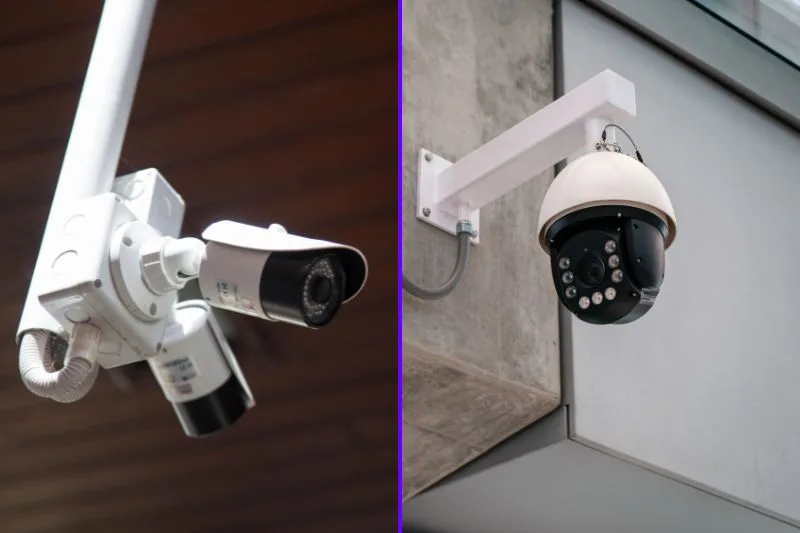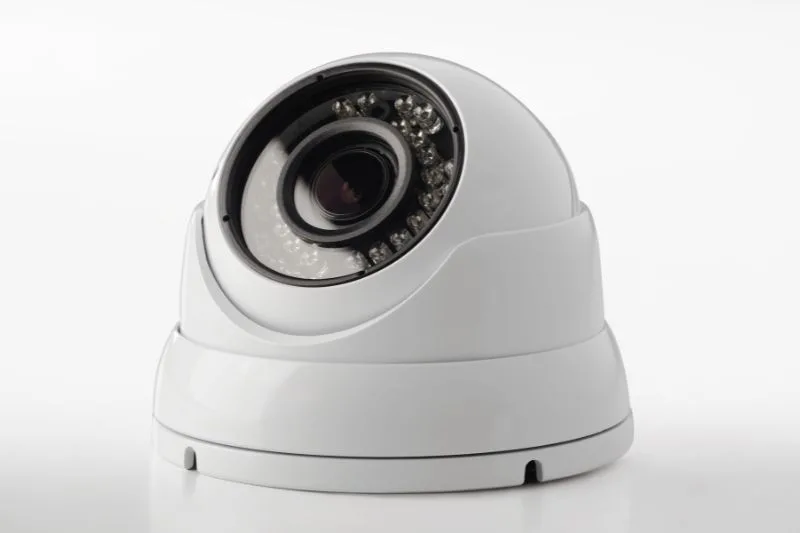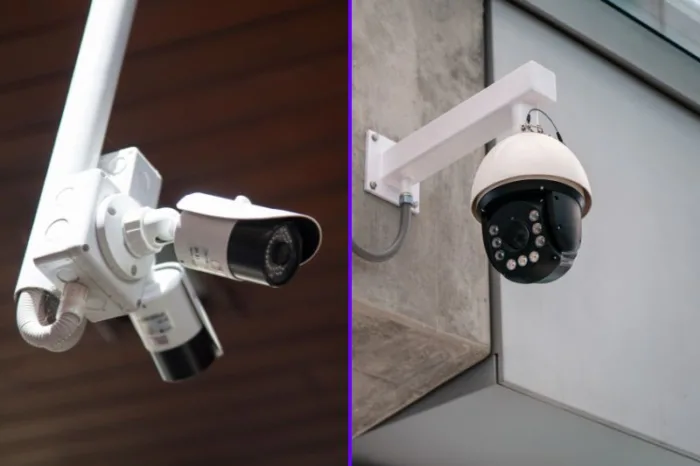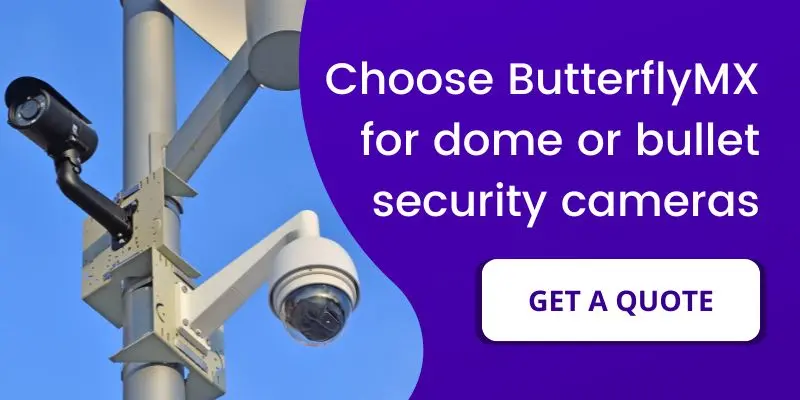Key takeaways
- Bullet cameras get their name from their cylindrical tube shape that closely resembles a bullet, making them ideal for long-range monitoring.
- Turret cameras have a dome-like form factor, so they’re suitable for wide-area monitoring.
- The choice between a bullet vs. turret camera comes down to your security needs, but it’s best to use a combination of the two for complete coverage.

When choosing the right security camera for your property, the options can be overwhelming, from dome and bullet to fisheye and PTZ cameras. Of course, the most popular types are bullet and turret cameras. Each of these camera types has its advantages and disadvantages, making them suitable for different situations.
So, this blog post will guide you through the differences between bullet vs. turret cameras, helping you make an informed decision about which is best for your security needs.
This guide covers:
- What are bullet cameras?
- What are turret cameras?
- Differences between bullet vs. turret cameras
- Which is better, bullet or turret camera?
- Best bullet security camera
What are bullet cameras?
Bullet cameras are named for their distinctive, cylindrical shape, resembling a bullet. This design isn’t just for show; it serves a practical purpose by allowing the camera to house larger lenses, which are crucial for capturing clear images over long distances.
Because of their shape and the ability to focus on specific areas, bullet cameras are highly effective in both commercial indoor and outdoor settings. They excel at monitoring spaces from a distance, making them the go-to choice for areas like long hallways, large parking lots, or any open spaces where you need to capture detailed footage from afar.
In addition, bullet cameras are ideal for monitoring critical points such as entryways and exits. Their prominent design acts as a visual deterrent, making them an excellent choice for locations where you want to signal that an area is clearly under surveillance. As a result, bullet cameras are particularly well-suited for protecting perimeters, entrances, and other vulnerable points in a building’s security.
What are turret cameras?
Also referred to as “eyeball cameras,” turret cameras get their name from their dome-like shape resembling a turret. The turret camera’s design allows it to be easily adjusted within its housing, giving you greater flexibility to direct the lens exactly where you need it without moving the entire camera.
The compact and versatile design of turret cameras makes them highly effective in both indoor and outdoor settings. Not to mention, turret cameras have a discreet design and flexible installation options, making them particularly well-suited for indoor settings. However, their weather-resistant housing also makes them a strong candidate for outdoor use, especially in places where a less obtrusive security presence is desired.
Differences between bullet vs. turret cameras
While both bullet and turret cameras are used for video surveillance, they have distinct differences that impact their performance when serving security requirements.
Let’s dive into comparing bullet vs. turret cameras:
Design
The most notable difference between these cameras is their design. Bullet cameras have a long, cylindrical shape, making them highly visible. Thus, bullet cameras are ideal for settings where a strong security presence is required, increasing the chances of deterring potential bad actors.
Conversely, turret cameras are more compact and have a dome-like design, enabling them to blend seamlessly into any environment. For that reason, turret cameras are better suited for locations that require discretion.
Installation
Both cameras are relatively easy to install regardless of whether the cameras are Power over Ethernet (PoE) connected or wireless. However, the bullet camera’s narrower field of view makes adjusting a little more challenging. If you install the camera and can’t get the angle you want, you may need to remount the camera entirely.
Turret cameras, on the other hand, have more flexibility in installation, thanks to their housing. The camera can easily rotate and tilt within, allowing you to easily adjust the angle without needing to reposition the entire camera.
Watch how the ButterflyMX platform works:
Durability
The bullet and turret cameras come in highly durable models with ingress protection (IP), impact, and vandal-resistant ratings. Of course, the manufacturer you choose will ultimately determine your camera’s durability.
Generally speaking, turret cameras typically have the upper hand. These cameras often have a higher ingress protection (IP) rating, showcasing how they can withstand various dust and water conditions. Bullet cameras can also be weatherproof, but their IP rating may not be as high.
When it comes to vandalism, bullet cameras are usually more susceptible because of their more prominent design. Plus, bullet cameras are easier to grab, so it’s best to install them out of reach. Meanwhile, turret cameras are less noticeable and are more difficult to tamper with due to their dome-like shape.
Field of view
Bullet cameras are known for their long-range capabilities, which is one of their main advantages. This makes them ideal for monitoring large areas from far distances, such as parking lots, entrances, and driveways.
Turret cameras, while still effective, generally have a shorter range than bullet cameras. However, their flexible design allows them to cover a wider angle, making them a good choice for monitoring smaller areas or spaces that require a wide field of view, like a lobby or gym.
Cost
The cost of bullet and turret cameras is comparable. Nonetheless, costs of the camera will come down to the brand, features, and specifications. The price difference, if there is one, is often minimal. Ultimately, the choice between the two should come down to what you’re looking for in a security camera system.
Use cases
Bullet cameras are commonly used in outdoor and indoor settings where a long-range and highly visible camera is needed.
Examples of where you might find bullet cameras include:
- Entryways or exits
- Perimeters
- Hallways
- Parking lots
- Driveways or roads
- Loading docks
- Warehouses
- Construction sites
Turret cameras, with their compact and flexible design, are better suited for indoor use or areas where a less conspicuous camera is desired.
Use cases of turret cameras include:
- Lobbies and reception areas
- Retail stores
- Offices
- Stairwells
- Garages
- Gyms
- Restaurants
- Schools

Which is better, bullet or turret camera?
Neither the bullet nor the turret camera is better than the other because each is designed for different purposes.
Choosing between a bullet or turret camera depends on the application, as each is designed for different purposes. Bullet cameras are ideal for long-range outdoor monitoring and act as a strong visual deterrent, while turret cameras offer flexibility and discretion, making them better suited for indoor use or areas requiring a less noticeable presence.
If you need indoor and outdoor surveillance, using a combination of bullet and turret cameras is the best solution. Together, they can provide comprehensive coverage to ensure greater insights into how your business operates without leaving any blind spots.
Best bullet security camera
The best bullet security camera is ButterflyMX’s Bullet Camera.
ButterflyMX is a leading cloud-based access control company that’s been installed in more than 15,000 buildings and garnered over 40,000 five-star reviews.
With our Bullet Camera, you can integrate seamlessly with the ButterflyMX OS, allowing you to manage your cameras remotely alongside all our other products: Dome Security Camera, Video Intercom, Access Control, Front Desk Station, Elevator Controls, and more.
Overall, the ButterflyMX Bullet Security Camera has the following features:
- Long-range coverage. Record video footage from up to 300 yards away in high-definition, ensuring you get the security insights occurring at your property.
- 24/7 HD recording. Capture high-definition video footage all day and night with continuous recording, giving you greater insights into how your property operates and boosting security.
- Night vision. Know your security cameras will capture footage at night with the Bullet Camera’s 18 infrared LEDs for clear video up to 95 feet in low-light conditions.
- Cloud storage. Store up to a week’s worth of video footage to easily refer back to footage in the event of a security breach, decreasing the amount of time it takes to investigate.
- Durability. Our Bullet Security Camera features a highly durable housing with IP66 weather resistance, IK10 impact resistance, and even 4,000V lighting protection.
- PoE installation. Make the installation process simple by choosing our Bullet Security Camera, which requires only a single PoE cable.







